JD.com Inc., also known as Jingdong, is a leading Chinese e-commerce company headquartered and based in China.
Although I don’t think investors need any form of introduction to the e-commerce retail space giants, many may not know that JD is not just a pretty face e-commerce marketplace that is gathering market share throughout and across China.
As a technology-driven company, JD.com builds reliable and scalable platforms that complete the eco-system and bring value to partners and customers in sectors such as e-commerce, logistics, internet finance, health, cloud computing and smart technology.
The key tenet of the business model lies in getting its users, both demand and supply benefit from the entire eco-system it has built, from product to technology to service delivery – a concept that a network liquidity flywheel has so much impact and exponential function of growth it does to the business.
This helps to create a vicious powerful flywheel cycle and an enormous net retention value as well as boosting the customer’s lifetime value in the key unit economy (LTV).
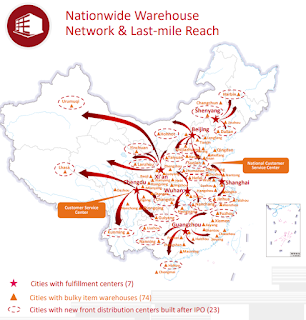
Q4 FY2020 Earnings Results
If you look at the recent results and breakdown below, you would notice that 87.4% of JD.com revenue comes from its product revenues while the rest of the 12.6% is derived from its service streams. This validates the amount of effort JD has tried to build its product to integrate with its entire ecosystem.
Core revenues for Q4 from its product increased by 28% YoY while services increased by 53% coming in from a lower base. If we look at the average CAGR across the past 5 years from 2015-2020, JD has an impressive CAGR of 31% and 48% for its product and services segment respectively and its latest Q4 results doesn’t disappoint.
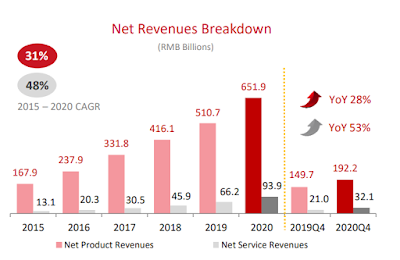 |
| Source: JD.com Earnings Results |
If we look at the breakdown of its Product Revenues segment, both general merchandising and electronics and home appliances are registering strong YoY increases. This is attributed to the company moving in to the lower-tiered cities where access to online merchandizing and electronics aren’t as prevalent as yet.
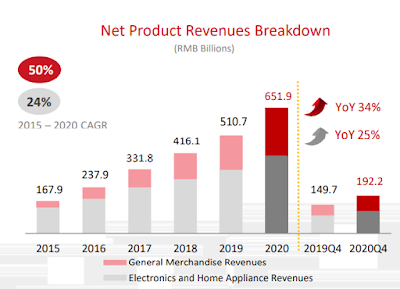 |
| Source: JD.com Earnings Results |
For breakdown of its Services Revenues segment, you can see that Logistics will be a key play in the next few years. Q4 Logistics revenues increased by as much as 95% YoY and past 5 years CAGR has increased by 76%.
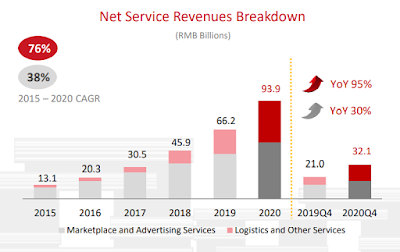 |
| Source: JD.com Earnings Results |
While revenues have been registering mind-blowing growth, topline and operating margins on the other hand are something which investors need to take a close look at, as this will indicate if the productivity and economies of scale ecosystem they have been trying to build up is taking places and making positive movement.
Topline Margins for Q4 has dropped marginally from 14.1% to 13.9% and Fulfilled orders margins have also dropped from 7.6% to 7.3% – something to monitor a bit more closely.
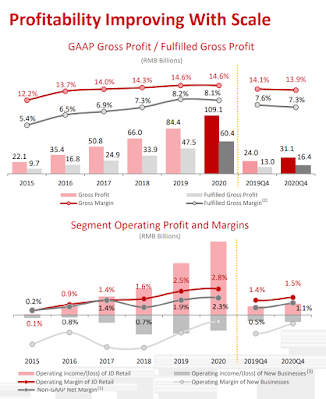 |
| Source: JD.com Earnings Results |
JD business model which results in its free cash-flow generative ability is a lot to envy and die for.
The company business model quantifies its strong cashflow through its excellent working capital turnover, as the company takes typically around 50 days to pay their supplier but only 2 to 3 days to receive that cash from its customer which they can continue to pump and regenerate back into the profits through investing in capex.
The company spent an average of about RMB 10 billions on capex throughout the years, with exception to 2018 when they had to spend RMB 21 billions for its development properties (which by the way today is generating cash-flow business).
We should expect the free-cash flow to run through the roof in the upcoming few years to come assuming capex stays at a constant RMB 10 billions a year. If they decide to plough it back into a new business, we should see a new revenue stream to come.
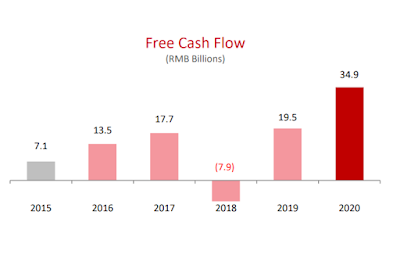 |
| Source: JD.com Earnings Results |
Regulatory Risk To Take Note
The State Administration for Market Regulation announced an investigation into Alibaba monopolistic conduct a few months ago with the likes of Taobao and Tmall particularly in scope, which was investigated for its exclusive ultimatum pick for providers to choose either “one out of the two but not both” – essentially forcing providers a binary decision to go with or without.
As it turns out, the regulators weren’t singling out on Alibaba’s model solely.
Chinese regulators also started imposing a wide-ranging restrictions on fast-growing e-commerce companies with the likes of Meituan and JD being summoned for investigation.
The result of the investigation could result in the companies splitting up to meet the regulatory requirement moving forward. The changes will likely hit profits and growths as they have to set up several holding companies as vehicle, which will require more capital and be more regulatory sanctioned and monitored.
Valuation
JD is a highly cash generative business, so we’ll use the discounted cashflow to see where its valuation is.
Current net debt in their books is at RMB 37.7 billions, which is translated to about USD 5.8 billions. For conservative purpose, we’ll deduct off this debt portion from our terminal cashflow calculation in deriving our intrinsic value.
 |
| Actual Cashflow from 2015 – 2020 (Source: Author’s Working) |
Worst Case Scenario:
For our worst case scenario, we assume a terminal growth rate of 10%, which we’ve pegged the same level to the capex to arrive at the underlying unlevered free cash flow.
The terminal value is then subtracted by the net debt of $5.8 billions for conservativeness before we discount it to our net present value of today’s price.
WACC sensitivity rate used throughout is leveled across from 8-10% for reference, but a middle of 9% is likely more sensible.
Different Cashflow multiple of 10x, 15x and 20x is tabled consistently across the three scenarios in order to arrive at the same conclusion throughout.
Based on a 10% growth rate, WACC 9% and a cashflow multiple of 15x (Morningstar recommended), we arrive at the intrinsic value of $68.5, which is about 10% off today’s market price of around $76.
 |
| Worst-Case Scenario (Source: Author’s Working) |
Base Case Scenario:
We assume our base case as the scenario that is more probably and likely to happen.
For our base case scenario, we assume a terminal growth rate of 20% – still below the average range of the past 5 years CAGR and also its most recent Q4 results which a kind reminder to readers is still growing at 28%. We’ve pegged the same level to the capex to arrive at the underlying unlevered free cash flow.
Similarly, the terminal value is then subtracted by the net debt of $5.8 billions for conservativeness before we discount it to our net present value of today’s price.
The same WACC and Cashflow Multiple sensitivity rate used throughout to arrive at the same conclusion thereabout.
Based on a 20% growth rate, WACC 9% and a cashflow multiple of 15x (Morningstar recommended), we arrive at the intrinsic value of $103.7, which is about 35% upside today’s market price of around $76.
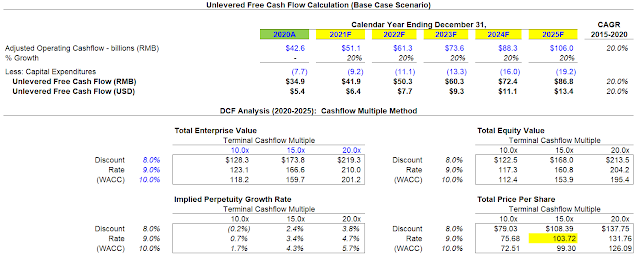 |
| Base Case Scenario (Source: Author’s Working) |
Best Case Scenario:
We try not to be overly optimistic but there is a good chance the best case scenario could play out right in our hands.
For our best case scenario, we assume a terminal growth rate of 28% – right on spot with its most recent Q4 results with a gentle reminder to readers that the logistic arms is still growing from a low base and has grown by over 90% YoY in Q4. While the logistic arms will continue to massively grow by high double digit over the next few years, it may not trickle down the same to the free cash flow as logistics tend to incur higher amount of cape and upfront working capital, which could negate the impact on its cashflow.
We’ve pegged the same level to the capex to arrive at the underlying unlevered free cash flow.
Similarly, the terminal value is then subtracted by the net debt of $5.8 billions for conservativeness before we discount it to our net present value of today’s price.
The same WACC and Cashflow Multiple sensitivity rate used throughout to arrive at the same conclusion thereabout.
Based on a blended 28% growth rate, WACC 9% and a cashflow multiple of 15x (Morningstar recommended), we arrive at the intrinsic value of $141.2, which is about 83% upside today’s market price of around $76.
 |
| Best Case Scenario (Source: Author’s Working) |
Blended Average:
Next, we attribute the probability of all the three scenario happening – with 10% attributed to worst case scenario, 60% attributed to base case scenario, and 30% attributed to best case scenario.
It resulted in an blended intrinsic value of 10% x $68.5 + 60% x $103.7 + 30% x $141.2 = $111.4.
Technical Charts & Entry Level:
JD’s immediate support is at $75.5, which coincides with the EMA50 weekly support. Next immediate support level is at $72, which is not too far away.
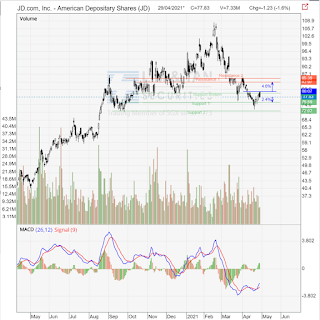 |
| Source: Chartnexus |
With the worst case scenario intrinsic value coming in at $68.5, and immediate support right at $72 and $75, I have taken a position on the sell put for these three levels for the next few months all the way leading up to December.
Premiums for December with strike price $70 is still at mouth-watering level of $4.40, which translates into a “yield” of around 6.3% for a period of 8 months or 9.5% annualized.
If the stock rises ahead of schedule, you will have the option to close out your positions early and reinvest it elsewhere. If it hits your strike price, you are in a good position where you are buying the company at a pretty good level.
Win-win in either case.
Alternatively, you can also take up a direct long position at around the $72-$75 level to ride the upside.
Do remember that selling put robs you of potentially enjoying the upside and with a blended average intrinsic value computed above of around $111, it might just be worthwhile getting the stock directly.


Kindly translate price to Hk listed counter. Thanks
Hi Ivy
You can take ADR 2:1 ratio then convert into HKD.
For e.g: USD 77 x 7.75 / 2 = HKD 298
Is there any difference between buying the us listed counter and the hk counter?
There isn't for now, but if you are worried about the hassle of potential delisting impact, you can buy straight into the HK listed.
Hi,
Nice strategy, however why don't you sell weekly or 2 weekly put options instead. Profit per day will be much higher and it allows you to be more flexible to switch to owning stock once those weekly puts are expired.
Hi
If time decay and profits are the main agenda, then I agree those shorter time frame will make sense. I am trying to manage some sort of risk so I'm spreading out the wings a little more by creating a ladder month so I won't get chances to be assigned all at one go (even though they are attractive).
can consider using sum of parts to value JD
they have stakes in
JD logistics
JD health
JD technologies
as well as stakes in listed companies such as farfetch, vip.com etc
SOTP valuations can easily hit 200bil vs current market cap of 120 bil
so there is a lot of upside
ML here btw, I bought into JD at 78 level
currently I am all in on chinese tech alibaba tencent JD
cheers
Hi ML
Should bode well and payoff really well over next couple of years. It's consolidating period now for accumulation.
You can sell put in HKEX as well. I will do monthly sell put on 9618.HK to collect premium while waiting for the share price to drop.
Board of Secondary Education, Class 10th (HSLC/AHM) Public Examination in the month of March to April to the Public Examinations of 2021 under Assam State Gov. SEBA is Published in the HSLC or 10th Class final Examination Date Sheet or Routine in every year from the Month of December or January at Official Website postone.in. National Institute of Open Schooling is going to conduct the 11th or 12th Class annual final Examination in the month of March to April to the Public Examinations of 2021 Ministry of Human Resource Development.